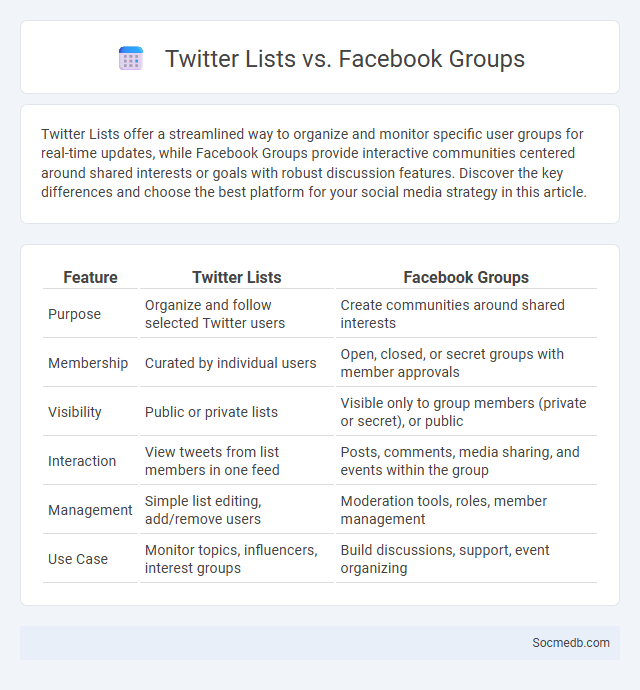
Photo illustration: Twitter Lists vs Facebook Groups
Twitter Lists offer a streamlined way to organize and monitor specific user groups for real-time updates, while Facebook Groups provide interactive communities centered around shared interests or goals with robust discussion features. Discover the key differences and choose the best platform for your social media strategy in this article.
Table of Comparison
| Feature | Twitter Lists | Facebook Groups |
|---|---|---|
| Purpose | Organize and follow selected Twitter users | Create communities around shared interests |
| Membership | Curated by individual users | Open, closed, or secret groups with member approvals |
| Visibility | Public or private lists | Visible only to group members (private or secret), or public |
| Interaction | View tweets from list members in one feed | Posts, comments, media sharing, and events within the group |
| Management | Simple list editing, add/remove users | Moderation tools, roles, member management |
| Use Case | Monitor topics, influencers, interest groups | Build discussions, support, event organizing |
Introduction: Understanding Social Media Organization Tools
Social media organization tools streamline content scheduling, audience engagement, and performance analytics across multiple platforms, enhancing efficiency for marketers and businesses. These tools integrate features such as content calendars, real-time monitoring, and automated posting to optimize social media strategies. Leveraging platforms like Hootsuite, Buffer, and Sprout Social improves coordination, brand consistency, and data-driven decision-making.
Overview of Twitter Lists
Twitter Lists enable users to organize and categorize accounts for streamlined content consumption and monitoring. These curated groups allow for easy tracking of specific topics, industries, or interests without cluttering the main timeline. Leveraging Twitter Lists enhances engagement by providing focused insights and fostering targeted community interactions.
What Are Facebook Groups?
Facebook Groups are dedicated spaces within the Facebook platform where individuals with shared interests, goals, or communities can connect and interact. They enable You to join discussions, share content, and collaborate with members based on specific topics or purposes, such as hobbies, professional networking, or support. These groups can be public, closed, or secret, offering varying levels of privacy and control over membership and content visibility.
Exploring Trending Topics Across Platforms
Analyzing trending topics across social media platforms reveals real-time insights into global conversations, enabling brands to tailor content strategies effectively. Platforms like Twitter, Instagram, and TikTok showcase viral hashtags, popular challenges, and emerging news, reflecting user engagement patterns and cultural shifts. Utilizing advanced analytics tools for trend monitoring helps businesses capitalize on peak user interest and optimize their digital marketing campaigns.
Key Features: Twitter Lists vs Facebook Groups
Twitter Lists enable you to organize users into curated feeds, offering a streamlined way to monitor specific interests or influencers without cluttering your main timeline. Facebook Groups provide interactive communities centered around shared topics, allowing members to post content, engage in discussions, and collaborate with like-minded individuals. Your choice depends on whether you prefer personalized content aggregation via Twitter Lists or immersive community engagement through Facebook Groups.
Engagement and Community Building Comparison
Social media platforms like Facebook, Instagram, and Twitter each offer unique tools for engagement and community building, with Facebook groups fostering deeper connections through shared interests and Instagram emphasizing visual content to boost interaction. Twitter excels in real-time conversations, enabling swift engagement with trending topics and niche communities. To maximize Your impact, choose the platform that best aligns with Your audience's preferences and engagement goals.
Content Discovery: Trending Topics vs Lists vs Groups
Content discovery on social media hinges on leveraging trending topics, curated lists, and specialized groups to maximize your engagement and reach. Trending topics offer real-time pulses of popular conversations, while lists organize influencers and key accounts for targeted insights. Groups foster community-driven discussions, enabling deeper connections around shared interests and niche content.
Privacy and Moderation Differences
Social media platforms vary significantly in privacy settings and content moderation policies, impacting user experience and data security. Facebook employs robust privacy controls and AI-driven moderation to detect harmful content, while Twitter emphasizes real-time content review with user-reporting mechanisms. TikTok balances user engagement with strict data privacy regulations and employs a combination of automated tools and human moderators to manage content.
Use Cases: Which Tool Fits Your Needs?
Social media platforms offer diverse use cases tailored to different business goals, such as Instagram for visual brand storytelling and influencer marketing, LinkedIn for B2B networking and professional recruitment, and Twitter for real-time customer engagement and news dissemination. Choosing the right tool depends on your target audience, content type, and desired interaction, with Facebook excelling in community building and targeted advertising campaigns, while TikTok drives high engagement through short-form video content. Analyzing user demographics, engagement rates, and platform-specific features ensures strategic alignment with marketing objectives and optimal return on investment.
Conclusion: Choosing the Right Platform Feature
Selecting the right social media platform feature depends on target audience demographics, engagement goals, and content format compatibility. Features such as Instagram Reels support short-form video engagement, while LinkedIn's professional networking tools enhance B2B interactions. Prioritizing platform-specific functionalities maximizes reach and optimizes user interaction for marketing success.
 socmedb.com
socmedb.com